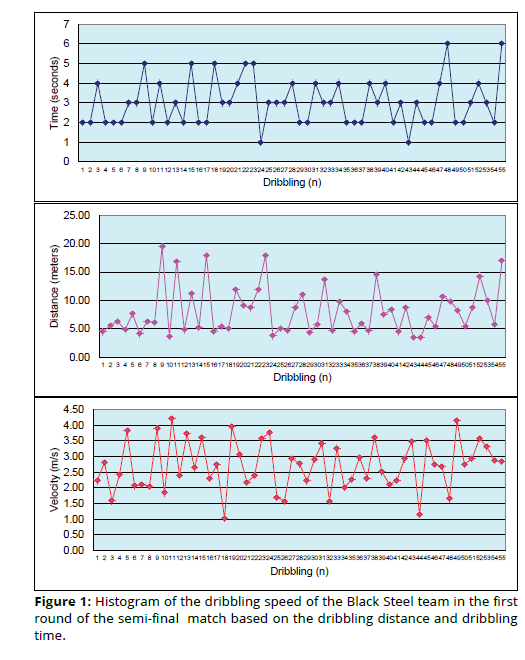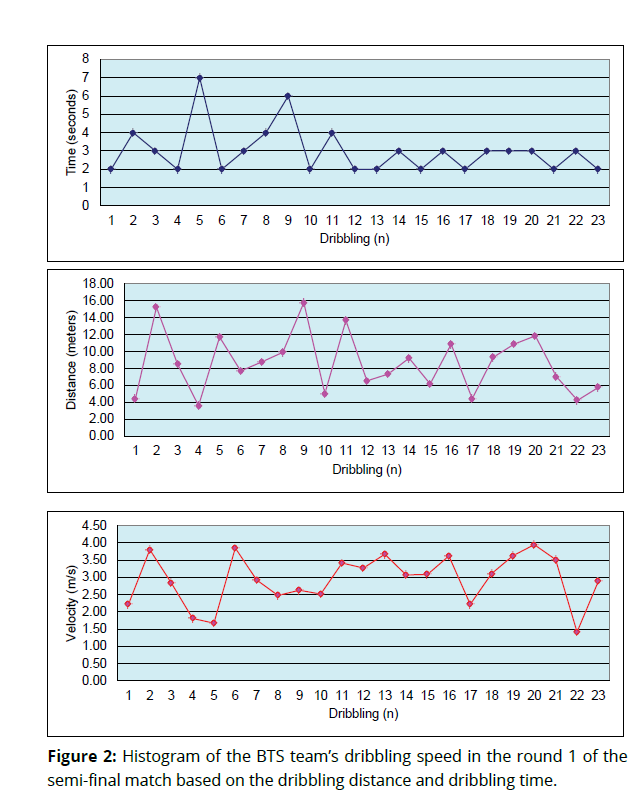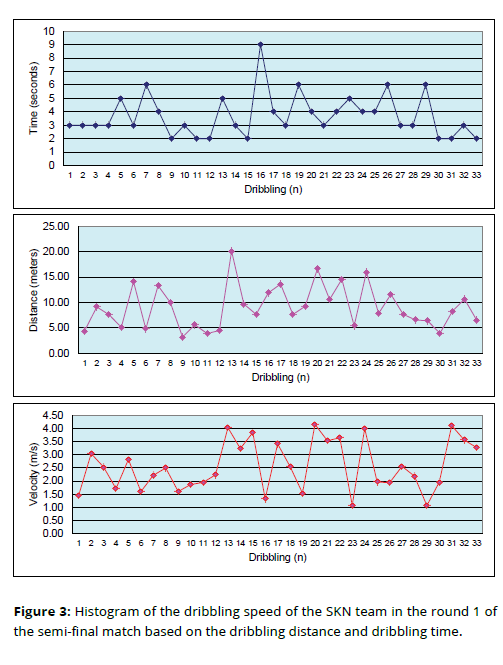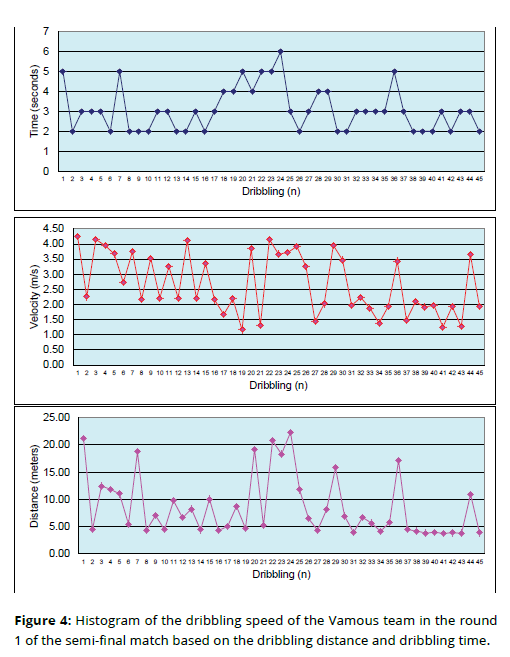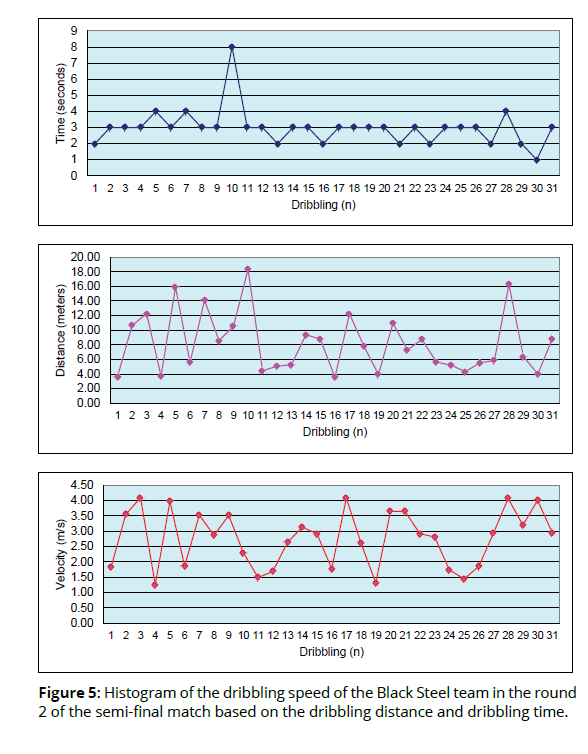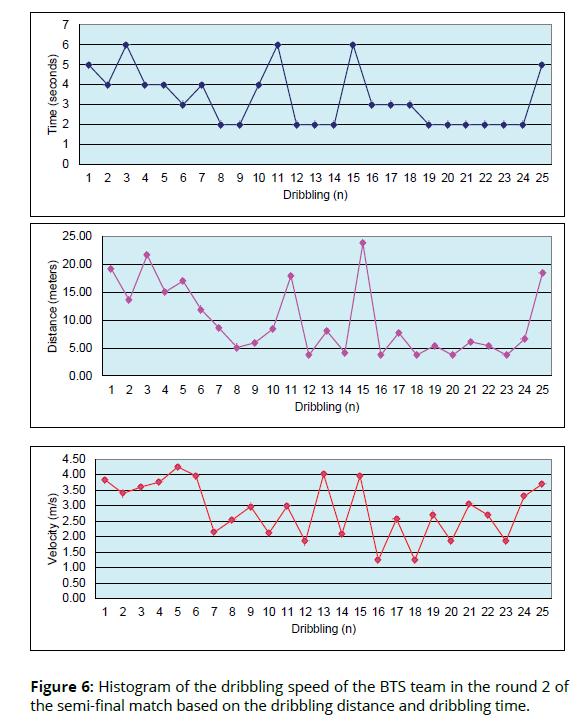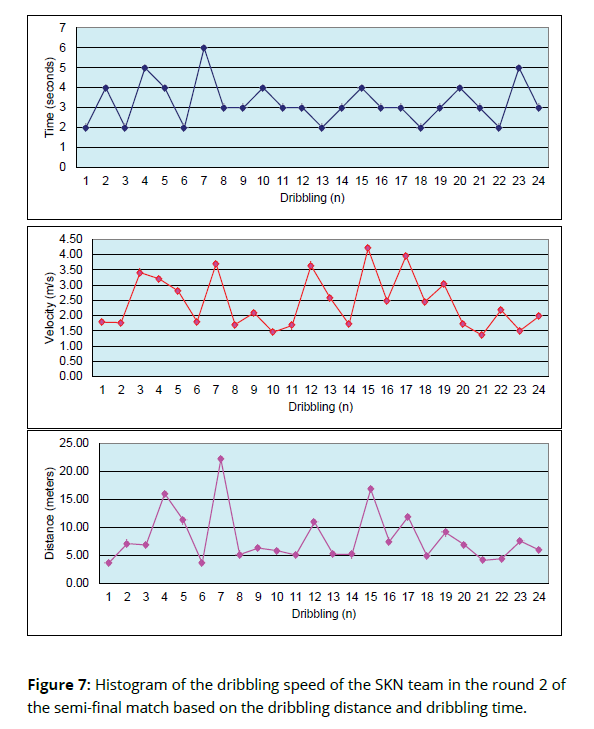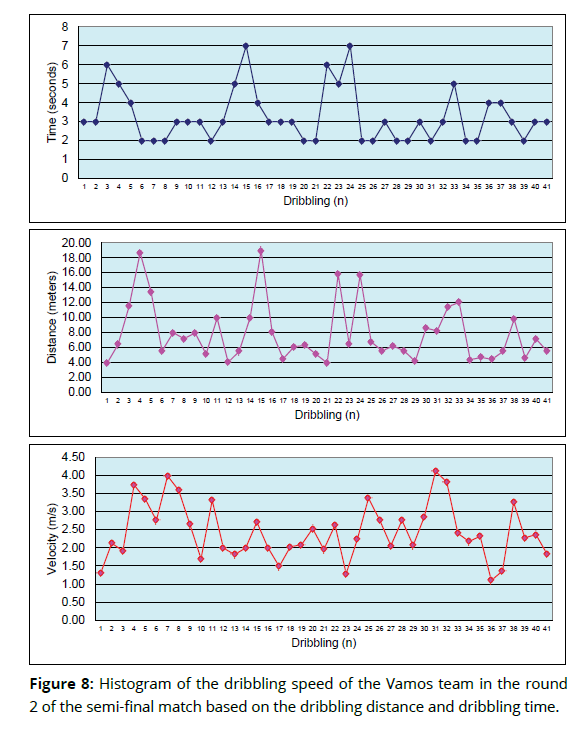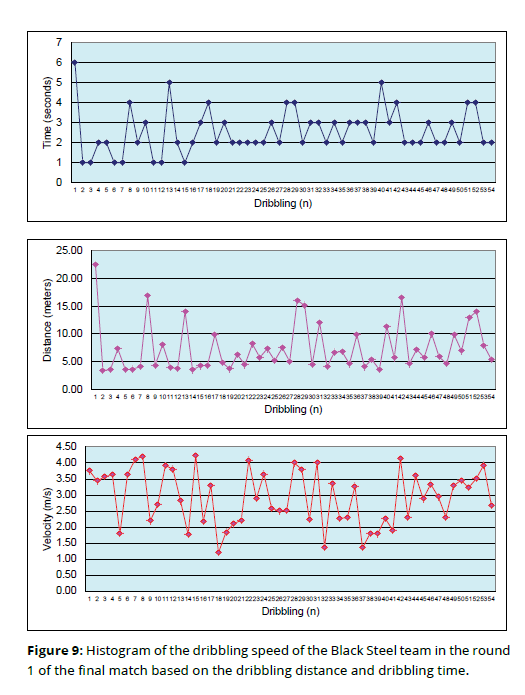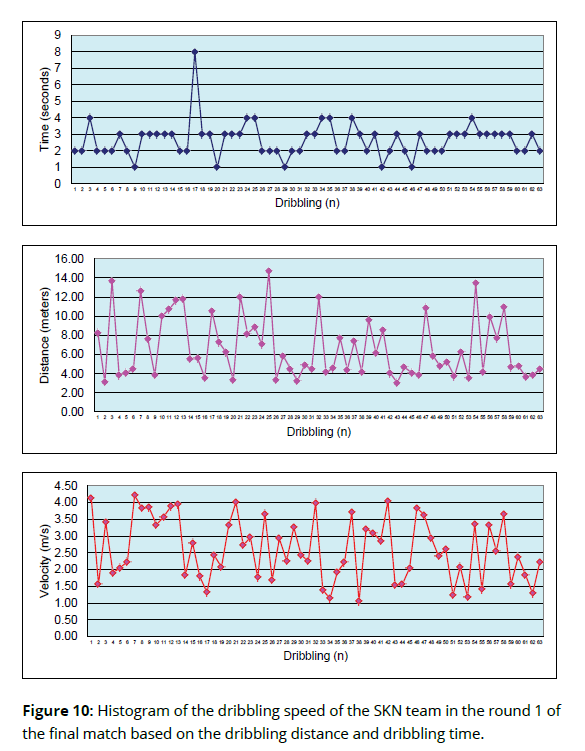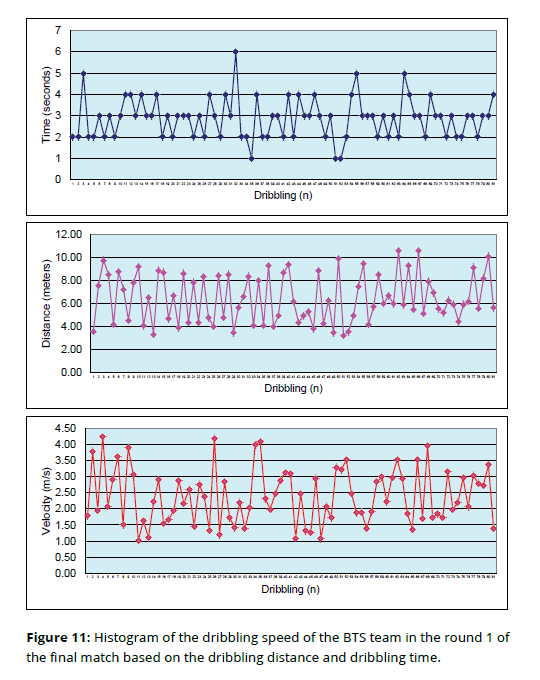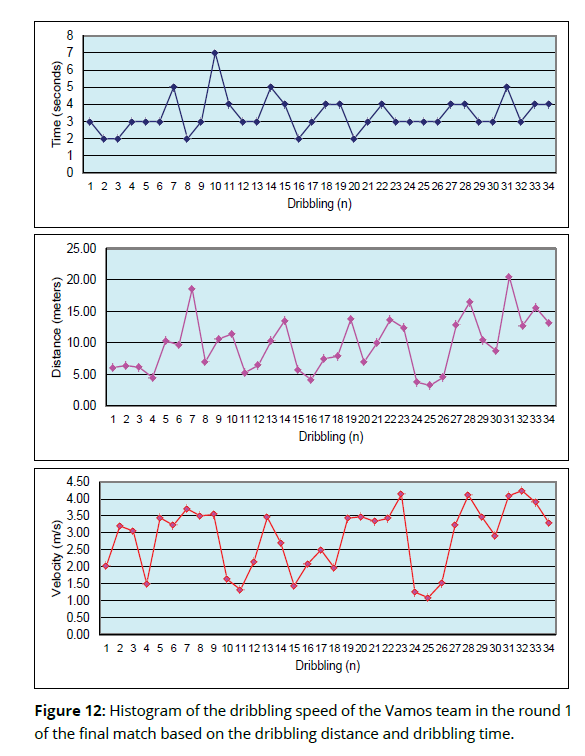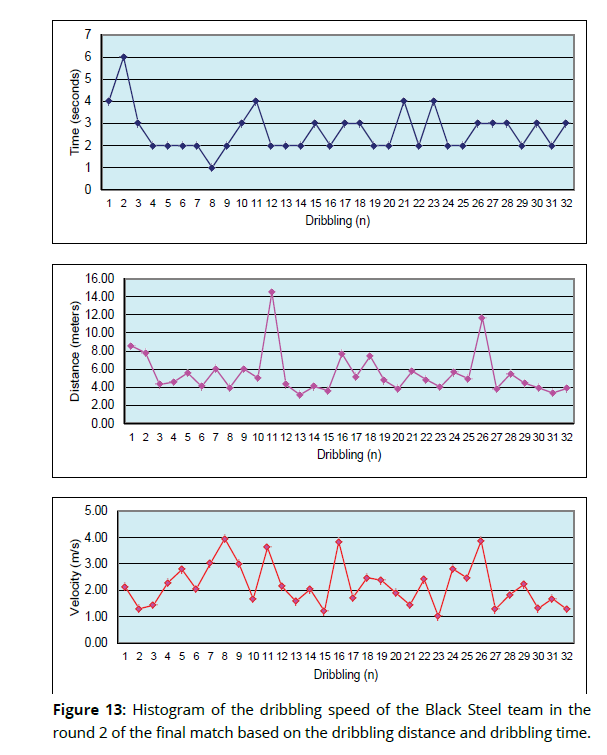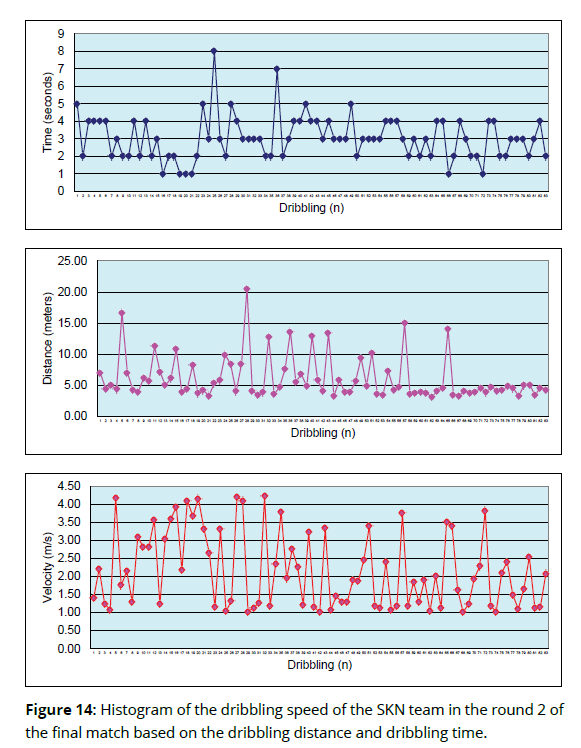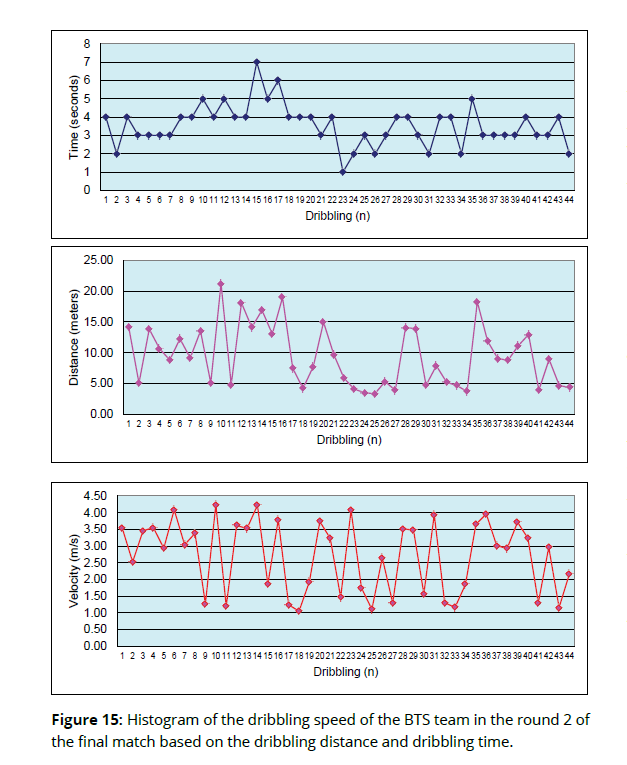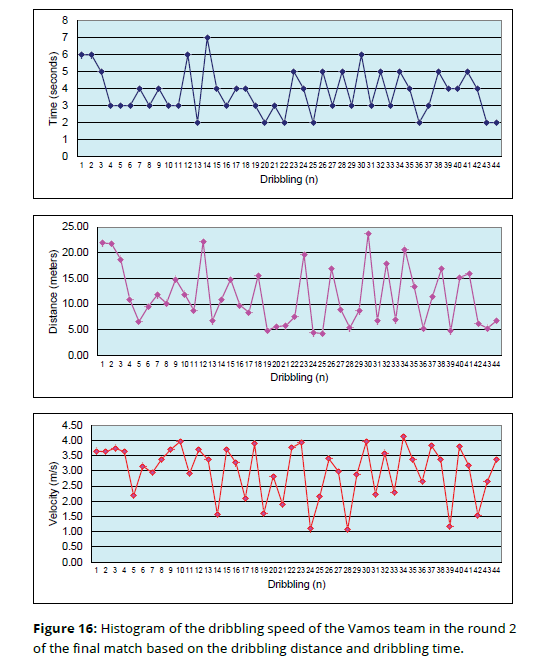Full Length Research Article - (2023) Volume 18, Issue 2
*Correspondence: Rumi Iqbal Doewes, Fakulti Sains Sukan dan Kejurulatihan, Universiti Pendidikan Sultan Idris, Perak Darul Ridzuan 35900, Malaysia, Email: Rumi Iqbal Doewes, Faculty of Sport, Universitas Sebelas Maret, Jl. Ir. Sutami, 36A, Kentingan, Surakarta, Indonesia,
Abstract
Futsal players must mastered dribbling in the attack and defend pattern. The study purposes was analyzed the speed dribbling of futsal players and compare speed dribbling between round 1 and round 2 in the match of 2021 Indonesian Futsal League semi-finals and finals. The study method was used cross sectional survey design. Sample consist of 4 matches (2 semi-finals matches and 2 final matches) played by 4 teams (40 players). Movie maker software was used for cutting video every movement dribbling and Kinovea software used for analysis the distance and time of dribbling. To determined the speed dribbling counts with formula of distance shared time. Player’s speed declared as total, mean, SD. Difference speed dribbling player among round 1 and round 2 each team and every match calculated using Wilcoxon. Research results showed that there is not significant difference statistically on speed dribbling in round 1 and round 2 in semi-finals and finals match (p = 0.199 for semi-finals and p = 0.172 for finals). The speed dribbling every team are not different statistically in the 1st and 2nd round of the final and semi-finals match, except speed dribbling of Black Steel and SKN team in the final match. By overall, on the semi-final and final match there are 712 times of dribbling with average speed dribbling of 2.60 ± 0.94 m/s, dribbling implemented during 3.09 second with distance dribbling of 7.90 meters. Percentage of speed dribbling in semi-finals matches from round 1 to round 2 decreased (57.170 % in round 1 and 42.830 % in round 2). Percentage of speed dribbling in the final match of round 1 to round 2 decreased (55.157 % in round 1 and 44.843 % in round 2). In conclusion, this research give implication for coach for arranges the player change pattern in the futsal match for prevent the drop of physics performance and tactics game suring futsal match.Keywords
Analysis, Speed, Dribbling, Futsal
Introduction
Dribbling is one of futsal basis technique which became principle performance of futsal player during matches (Ueda, et al., 2020). Dribbling were conducted during match play and considered as decisive skill that player have possibility for proceed more into the opponent’s area and defend possession of the ball, other than can becomes directive action of shot to goal or give passing, so this technique give big profit in matches (Padrón- Cabo, et al., 2020). Yiannaki, et al (2020) show that team statistics in futsal matches conduct 51 dribbling per team per game. In addition, Santos et al (2020) also show that main performance indicator of victory team is successful dribbling of 46.14% for the winning team, while 42.97% for losing/drawing team. Maintain winning match status needs more large dribbling effectiveness (Konefal et al., 2019).
The futsal purpose was score goals when the player has the ball and prevents goals when the opponent has the ball (Caglayan, et al., 2018). Successful ball dribbling shows the player’s defense of the ball to avoid players from the opposing team (Konefal et al., 2019). Improved dribbling is considered an important attribute in a player’s development. During the game, a player needs to move quickly to follow, control the ball and cross the opponent by completing dribbling. Dribbling as an individual tactic in a 1 vs 1 condition, a team that performs quality dribbling techniques during the match will more easily achieve victory (Lazarevi, et al., 2020). Dribbling speed is an important attacking strategy in matches when facing defenders and trying to block from close range (Wilson et al., 2019). Wilson et al (2019) also stated that assessing dribbling speed can predict a player’s success in attacking performance in 1 vs 1 condition. Therefore, coaches need to pay attention to the player’s dribbling speed as a training priority when preparing for a futsal competition.
Studying futsal dribbling speed in matches is a topic that is still rarely studied. In this context, research is very important to prepare for future competitions because it contributes to optimization of technical mastery in training. In line with this statement, Agras et al (2017) argue that basic technical analysis in matches has played a role in improving performance and helping coaches to make decisions, because match analysis provides knowledge about situations that occur in matches. Analyzing player movements during match situations can help coaches estimate the performance of futsal players and formulate exercises to overcome actual performance challenges in matches (Bueno, et al., 2014). Therefore, this study was conducted to analyze the dribbling speed of futsal players in the semi-finals and finals of the 2021 Indonesian Futsal League. In addition, this study also compare the dribbling speed between round 1 and round 2 to detect a possible decrease in dribbling speed performance in the matches .
Methodology
Method
Cross sectional survey design was used to observe the implementation of dribbling during the semifinal and final matches. Cross sectional are studies a dynamic with an approach, observation, or data collection at a certain moment which is momentary in nature and carried out simultaneously at the same time (Costi, et al., 2021).
Subject
The research sample is the semi-final and final match of the 2021 Indonesian Futsal League. The matches analyzed consist of 2 semi-final matches and 2 final matches played by 4 futsal teams, namely:
1. Black Steel FC Manokwari, West Papua, Indonesia (Black Steel)
2. Bintang Timur FC Surabaya (BTS)
3. SKN FC Kebumen (SKN)
4. Vamos FC Mataram (Vamos)
The semi-final matches consisted of Black Steel vs BTS and SKN vs Vamos matches. The final matches are the Black Steel vs SKN and BTS vs Vamos matches. Players who are in the position of playing as defender, winger, and pivot are analyzed for their dribbling speed, so the research samples are 40 players.
Procedure
The videos for the semi-finals and finals of the 2021 Indonesian Futsal League are input into the computer and then the dribbling movements of each player are analyzed starting from the cutting of the video using Movie Maker software. Then the results of the cutting video of the futsal dribbling movement were analyzed for the distance and time of dribbling using the Kinovea software. Dribbling distance and time are calculated as the cumulative number of consecutive frame moves. The analysis results of the dribbling distance are calculated in meters, and dribbling time are calculated in seconds. To more accurately characterize dribbling movements during the semifinal and final matches of the 2021 Indonesian Futsal League, the researcher analyzed every dribbling movement made by players during the game period in round 1 and round 2.
Data analysis
Dribbling speed is generated using the formula distance divided by time using Ms. Excel. The dribbling speed was expressed as total, mean, SD. Before each analysis, the Kolmogorov-Smirnov test showed that the data were not normally distributed. Because the data are not normally distributed, a nonparametric Wilcoxon test was performed to compare the dribbling speed of each round. The level of significance used is p < 0.05. All statistical procedures were performed using SPSS 16.
Results and Discussion
Research results
Table 1 shows a description of futsal dribbling speed data in the semi-finals and finals of the 2021 Indonesian Futsal League based on distance and time. The table shows that the number of dribbling performed by futsal players in the semi-finals and finals is 712 times with a total dribbling speed of 1851.16 m/s, the average dribbling speed is 2.60 ± 0.94 m/s, dribbling is carried out for 3.09 seconds with a dribbling distance of 7.90 meters (Table 1).
| Match | N | Total | mean | SD | Distance | Time |
|---|---|---|---|---|---|---|
| Semi-Finals and Finals | 712 | 1851.16 | 2.60 | 0.94 | 7.90 | 3.09 |
Table 2 shows the comparison of the average dribbling speed of semi-final and final matches in round 1 and round 2. p-value shows statistically there is not significant difference in the dribbling speed in round 1 and round 2 in semifinal matches (p = . 199) and the final match (p = . 172). In the semi-finals, the average dribbling speed in the round 1 was 2.702 m/s while round 2 was 2.610 m/s. In the final match, the average dribbling speed in round 1 is 2.648 m/s while for round 2 is 2.460 m/s (Table 2).
Match Condition |
Round 1 | Round II | p-value |
|---|---|---|---|
| Semi-finals | 2.702 ± 0.875 | 2.610 ± 0.868 | .199 |
| Final | 2.648 ± 0.914 | 2.460 ± 1.040 | .172 |
Table 3 shows the comparison of the average dribbling speed of each team in round 1 and round 2 in the semi-finals and finals of the 2021 Indonesian Futsal League. The p-value shows that there is a statistically significant difference in dribbling speed in round 1 and round 2 of the Black Steel and SKN team in final match, but in the semi-final match there is not significant statistically. The p-value also shows that there is not significant difference statistically in the dribbling speed of the BTS and Vamos teams in round 1 and round 2 of the final and semifinal matches (Table 3).
Match Condition |
Team | Round 1 | Round II | p-value |
|---|---|---|---|---|
| Semi-finals | Black Steel | 2.717 ± 0.776 | 2.761 ± 0.926 | .570 |
| BTS | 2.940 ± 0.725 | 2.872 ± 0.900 | .465 | |
| SKN | 2.560 ± 0.950 | 2.428 ± 0.869 | .732 | |
| Vamos | 2.667 ± 0.994 | 2.442 ± 0.766 | .288 | |
| Final | Black Steel | 2.926 ± 0.858 | 2.197 ± 0.827 | .002* |
| SKN | 2.615 ± 0.934 | 2.160 ± 1.048 | .047* | |
| BTS | 2.397 ± 0.856 | 2.697 ± 1.082 | .103 | |
| Vamos | 2.866 ± 0.959 | 2.982 ± 0.872 | .510 | |
| *Significant difference in dribbling speed in raound 1 and round 2 (p < 0.05) | ||||
In the semi-finals, the Black Steel team in round 1 had an average dribbling speed of 2.717 m/s, while in round 2 the average dribbling speed was 2.761 m/s, the BTS team in round 1 had an average dribbling speed of 2.940 m/s, while in round 2 the average dribbling speed is 2.872 m/s, the SKN team in round 1 has an average dribbling speed of 2.560 m/s, while in round 2 the average dribbling speed is 2.428 m/s, the Vamos team in round 1 has an average dribbling speed is 2.667 m/s while in round 2 the average dribbling speed is 2.442 m/s.
In the final match, the Black Steel team in round 1 had an average dribbling speed of 2.926 m/s while in round 2 the average dribbling speed was 2.197 m/s, the SKN team in round 1 had an average dribbling speed of 2.615 m/s while in the round.2 the average dribbling speed is 2.160 m/s, the BTS team in round 1 has an average dribbling speed of 2.397 m/s while in round 2 the average dribbling speed is 2.697 m/s, the Vamos team in round 1 has an average dribbling speed of 2.866 m/s while in round 2 the average dribbling speed is 2.982 m/s (Table 4).
Match Condition |
Round 1 | Round II |
|---|---|---|
| Semi-finals | 57.170 % | 42.830 % |
| Final | 55.157 % | 44.843 % |
Table 4 shows the percentage of dribbling speed in the semi-finals and finals match. The table shows a decrease in the percentage of dribbling speed from round 1 to round 2. The percentage of dribbling speed in the semi-finals of round 1 is 57.170 %, while the percentage of dribbling speed in round 2 is 42.830 %. The percentage of dribbling speed in the final round 1 was 55.157 %, while the percentage of dribbling speed in round 2 was 44.843 % (Figure 1).
Figure 1 shows the pattern of the different dribbling speed of the Black Steel team during the round 1 of the semi-final match based on the dribbling distance and dribbling time. From the 1st to the 55th dribbling, a significant increase in speed was found in the 11th dribbling with a dribbling speed of 4.22 m/s, and dribbling was carried out for 4 seconds with a dribbling distance of 16.88 meters (Figure 2).
Figure 2 shows the different dribbling speed pattern of BTS teams during round 1 of the semi-final match based on the dribbling distance and dribbling time. From the 1st to the 23rd dribbling, a significant increase in speed was found in the 20th dribbling with a dribbling speed of 3.95 m/s, and dribbling was carried out for 3 seconds with a dribbling distance of 11.84 meters (Figure 3).
Figure 3 shows the different of dribbling speed pattern the SKN teams during round 1 of the semi-final match based on the dribbling distance and dribbling time. From the 1st to the 33rd dribbling, a significant increase in speed was found in the 20th dribbling with a dribbling speed of 4.15 m/s, and dribbling was carried out for 4 seconds with a dribbling distance of 16.61 meters (Figure 4).
Figure 4 shows the different of dribbling speed pattern the Vamos teams during round 1 of the semi-final match based on the dribbling distance and dribbling time. From the 1st to the 45th dribbling, a significant increase in speed was found in the 22nd dribbling with a dribbling speed of 4.24 m/s, and dribbling was carried out for 5 seconds with a dribbling distance of 21.22 meters.
Figure 5 shows the different of dribbling speed pattern the Black Steel teams during round 2 of the semi-final match based on the dribbling distance and dribbling time. From the 1st to the 31st dribbling, a significant increase in speed was found in the 3rd dribbling with a dribbling speed of 4.09 m/s, and dribbling was carried out for 3 seconds with a dribbling distance of 12.27 meters (Figure 5).
Figure 6 shows the different of dribbling speed pattern the BTS teams during round 2 of the semi-final match based on the dribbling distance and dribbling time. From the 1st to the 25th dribbling, a significant increase in speed was found in the 5th dribbling with a dribbling speed of 4.25 m/s, and dribbling was carried out for 4 seconds with a dribbling distance of 17.01 meters (Figure 6).
Figure 7 shows the different of dribbling speed pattern the SKN teams during round 2 of the semi-final match based on the dribbling distance and dribbling time. From the 1st to the 24th dribbling, a significant increase in speed was found in the 15th dribbling with a dribbling speed of 4.21 m/s, and dribbling was carried out for 4 seconds with a dribbling distance of 16.82 meters (Figure 7).
Figure 8 shows the different of dribbling speed pattern the Vamos teams during round 2 of the semi-final match based on the dribbling distance and dribbling time. From the 1st to the 41st dribbling, a significant increase in speed was found in the 31st dribbling with a dribbling speed of 4.11 m/s, and dribbling was carried out for 2 seconds with a dribbling distance of 8.21 meters (Figure 8).
Figure 9 shows the different of dribbling speed pattern the Black Steel teams during round 1 of the final match based on the dribbling distance and dribbling time. From the 1st to the 54th dribbling, a significant increase in speed was found in the 15th dribbling with a dribbling speed of 4.23 m/s, and dribbling was carried out for 1 seconds with a dribbling distance of 4.23 meters (Figure 9).
Figure 10 shows the different of dribbling speed pattern the SKN teams during round 1 of the final match based on the dribbling distance and dribbling time. From the 1st to the 63rd dribbling, a significant increase in speed was found in the 7th dribbling with a dribbling speed of 4.22 m/s, and dribbling was carried out for 3 seconds with a dribbling distance of 12.65 meters (Figure 10).
Figure 11 shows the different of dribbling speed pattern the BTS teams during round 1 of the final match based on the dribbling distance and dribbling time. From the 1st to the 81st dribbling, a significant increase in speed was found in the 4th dribbling with a dribbling speed of 4.25 m/s, and dribbling was carried out for 2 seconds with a dribbling distance of 8.50 meters (Figure 11).
Figure 12 shows the different of dribbling speed pattern the Vamos teams during round 1 of the final match based on the dribbling distance and dribbling time. From the 1st to the 34th dribbling, a significant increase in speed was found in the 32nd dribbling with a dribbling speed of 4.25 m/s, and dribbling was carried out for 3 seconds with a dribbling distance of 12.74 meters (Figure 12).
Figure 13 shows the different of dribbling speed pattern the Black Steel teams during round 2 of the final match based on the dribbling distance and dribbling time. From the 1st to the 32nd dribbling, a significant increase in speed was found in the 8th dribbling with a dribbling speed of 3.96 m/s, and dribbling was carried out for 1 seconds with a dribbling distance of 3.96 meters (Figure 13).
Figure 14 shows the different of dribbling speed pattern the SKN teams during round 2 of the final match based on the dribbling distance and dribbling time.
From the 1st to the 83rd dribbling, a significant increase in speed was found in the 32nd dribbling with a dribbling speed of 4.23 m/s, and dribbling was carried out for 3 seconds with a dribbling distance of 12.69 meters (Figure 14).
Figure 15 shows the different of dribbling speed pattern the BTS teams during round 2 of the final match based on the dribbling distance and dribbling time. From the 1st to the 44th dribbling, a significant increase in speed was found in the 10th dribbling with a dribbling speed of 4.24 m/s, and dribbling was carried out for 5 seconds with a dribbling distance of 21.20 meters (Figure 15).
Figure 16 shows the different of dribbling speed pattern the Vamos teams during round 2 of the final match based on the dribbling distance and dribbling time. From the 1st to the 44th dribbling, a significant increase in speed was found in the 34th dribbling with a dribbling speed of 4.13 m/s, and dribbling was carried out for 5 seconds with a dribbling distance of 20.66 meters (Figure 16).
Discussion
Indoor football (futsal) games are characterized by physical performance and skill with high efforts during the competition period and the time is interspersed with changes in physical effort from time to time in accordance with the requirements and conditions of the game (Jawad, et al., 2021). This study aims to analyze the dribbling speed of players and compare the dribbling speed during the semi-finals and finals of the 2021 Indonesian Futsal League. Variables are distinguished based on round 1 and round 2. Overall, the average dribbling speed of players is 2.60 m/s, in which dribbling is carried out for 3.09 seconds with a dribbling distance of 7.90 meters. Based on team analysis, showed that the BTS team carried out the fastest dribbling during the semi-finals of round 1 and round 2, at a average speed of 2.940 m/s in round 1 and 2.872 m/s in round 2. In the final match of round 1, the Black Steel team also carried out the fastest dribbling at average 2.926 m/s, while in round 2 the team that carried out the fastest dribbling was the Vamos team at average 2.982 m/s. This shows that in futsal matches, semi-finals and finals, certain dribbling performances are presented.
This study also analyzed the dribbling speed of each team separately as shown in Figure 1-16 to better characterize the dribbling speed profile of each different team. The fastest dribbling in this futsal match for the Black Steel team is 4.23 m/s, where dribbling is carried out for 1 seconds with a dribbling distance of 4.23 meters. The fastest dribbling in this futsal match for the BTS team is 4.25 m/s where the dribbling is carried out for 2 seconds with a dribbling distance of 8.50 meters. The fastest dribbling in this futsal match for the SKN team is 4.23 m/s, where dribbling is carried out for 3 seconds with a dribbling distance of 12.69 meters. The fastest dribbling in this futsal match for the Vamos team is 4.25 m/s, where dribbling is carried out for 3 seconds with a dribbling distance of 12.74 meters. This can be taken into consideration by the coach in planning and compiling speed dribbling exercises for each of the futsal teams. Based on the percentage of dribbling speed of each match by round, the players investigated in this study showed a decrease in dribbling speed from round 1 to round 2. Similar to Bueno’s research (2014) in terms of distance traveled based on speed range which showed a decrease in physical performance from round 1 to round 2. According to Barbero-Alvarez et el (2008), decreased physical performance is associated with changes in physiological conditions such as reduced glycogen stores, thermal stress, and dehydration during competition. In this case, the athlete needs to maintain a higher level of activity due to the working period of the futsal game. Futsal games require high physical requirements because futsal games require a lot of work. Full physical preparation is needed by players to face the challenges of the game (Oudah, 2021).
Conclusion
This study shows that the average dribbling speed of players in the semi-finals and finals of the 2021 Indonesian Futsal League is 2.60 m/s where dribbling is carried out for 3.09 seconds with a dribbling distance of 7.90 meters. In addition, the percentage of dribbling speed from round 1 to round 2 has decreased in both the semi-final and final matches. Therefore, the rules of futsal matches allow unlimited substitutions, so the coach can consider substitutions during the game to prevent a decrease in physical performance and game tactics.
References
Agras, H., Ferragut, C., & Abraldes, J. A. 2016. Match analysis in futsal: a systematic review.International Journal of Performance Analysis in Sport,16(2), 652-686.
Barbero-Alvarez, J. C., Soto, V. M., Barbero-Alvarez, V., & Granda-Vera, J. (2008). Match analysis and heart rate of futsal players during competition.Journal of sports sciences,26(1), 63-73.
Bueno, M.J.D., Caetano, F.G., Pereira, T.J.C., De Souza, N.M., Moreira, G.D., Nakamura, F.Y. Cunha, S.A., and Moura, F.A. 2014. Analysis of the distance covered by Brazilian professional futsal players during official matches. Sports Biomechanics, 13(3), 230-240, DOI: 10.1080/14763141.2014.958872.
Caglayan, A., Erdem, K., Colak, V., & Ozbar, N. (2018). The Effects of Trainings with Futsal Ball on Dribbling and Passing Skills on Youth Soccer Players.International Journal of Applied Exercise Physiology,7(3), 44-54.
Costi, S., Paltrinieri, S., Bressi, B., Fugazzaro, S., Rossi, P.G., and Mazzini, E. 2021. Poor Sleep during the First Peak of the SARS-CoV-2 Pandemic: A Cross-Sectional Study. International Journal of Environmental Research and Public Health, 18. https://doi.org/10.3390/ijerph18010306.
Jawad, W. K., Ahmed, A. A., & Zamil, A. R. (2021). The Effect Of Stress Play Exercises On Developing Physical And Skill Performance And Performance Effectivenessfor Football Players Inside The Futsal Youth.Multicultural Education,7(7), 538-543.
Konefał, M., Chmura, P., Rybka, K., Chmura, J., Huzarski, M., & Andrzejewski, M. (2019). What frequency of technical activity is needed to improve results? New approach to analysis of match status in professional soccer.International journal of environmental research and public health,16(12), 22-33.
Lazarević, P., Milosavljević, S., & Petrović, S. (2020). Notational Analysis Of Uefa Europa League Match Malmö FF-CHELSEA FC. SPORT – Science & Practice, 10(2), 47-58.
Oudah, R. H. (2021). The Effect Of Speed Training In Developing Complex Skill Performance And Quick Counterattack In Futsal.Journal of Natural Remedies,21(10 (2)), 99-108.
Padrón-Cabo, A., Rey, E., Kalén, A., & Costa, P. B. (2020). Effects of training with an agility ladder on sprint, agility, and dribbling performance in youth soccer players.Journal of human kinetics,73, 219-228.
Santos, J., Mendez-Domínguez, C., Nunes, C., Gómez, M.A., and Travassos, B. 2020. Examining the key performance indicators of all-star players and winning teams in elite futsal, International Journal of Performance Analysis in Sport, 20(1), 78-89, DOI: 10.1080/24748668.2019.1705643
Ueda, L.S.C., Menegassi, V.M., Avelar, A., Rechenchosky, L., Silva, F.L.O., & Borges, P.H. 2020. Analysis Of The Execution Of Core Tactical Principles And Technical Efficiency Of Primary School Futsal Players. Rev Bras Cineantropom Desempenho Hum, 22:e65221. DOI: http://dx.doi.org/10.1590/1980-0037.2020v22e65221.
Wilson, R. S., Smith, N. M., Ramos, S. D. P., Giuliano Caetano, F., Aparecido Rinaldo, M., Santiago, P. R. P., ... & Moura, F. A. (2019). Dribbling speed along curved paths predicts attacking performance in match-realistic one vs. one soccer games.Journal of sports sciences,37(9), 1072-1079.
Yiannaki, C., Barron, D., Collins, D., & Carling, C. 2020. Match Performance In A Reference Futsal Team During An International Tournament – Implications For Talent Development In Soccer. Biology of Sport, 37(2), 147-156. DOI: 10.5114/biolsport.2020.93040.
